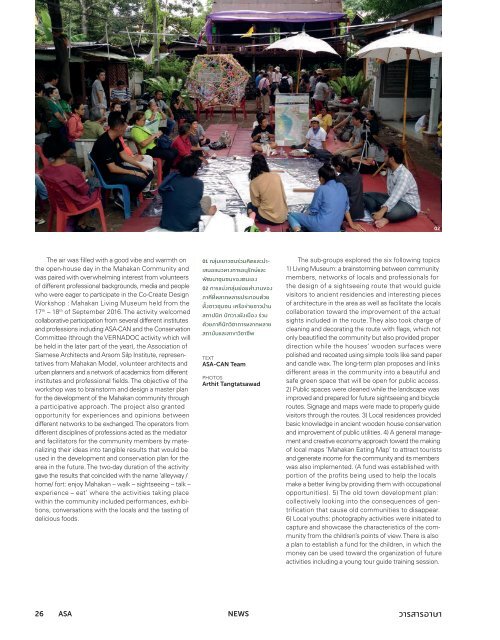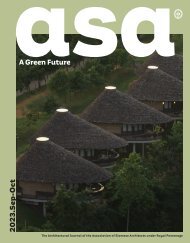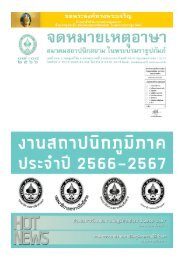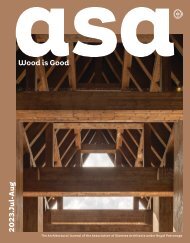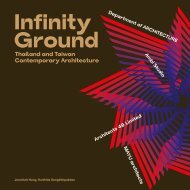ASA JOURNAL 06/59
Create successful ePaper yourself
Turn your PDF publications into a flip-book with our unique Google optimized e-Paper software.
02<br />
The air was filled with a good vibe and warmth on<br />
the open-house day in the Mahakan Community and<br />
was paired with overwhelming interest from volunteers<br />
of different professional backgrounds, media and people<br />
who were eager to participate in the Co-Create Design<br />
Workshop : Mahakan Living Museum held from the<br />
17 th – 18 th of September 2016. The activity welcomed<br />
collaborative participation from several different institutes<br />
and professions including <strong>ASA</strong>-CAN and the Conservation<br />
Committee (through the VERNADOC activity which will<br />
be held in the later part of the year), the Association of<br />
Siamese Architects and Arsom Silp Institute, representatives<br />
from Mahakan Model, volunteer architects and<br />
urban planners and a network of academics from different<br />
institutes and professional fields. The objective of the<br />
workshop was to brainstorm and design a master plan<br />
for the development of the Mahakan community through<br />
a participative approach. The project also granted<br />
opportunity for experiences and opinions between<br />
different networks to be exchanged. The operators from<br />
different disciplines of professions acted as the mediator<br />
and facilitators for the community members by materializing<br />
their ideas into tangible results that would be<br />
used in the development and conservation plan for the<br />
area in the future. The two-day duration of the activity<br />
gave the results that coincided with the name ‘alleyway /<br />
home/ fort: enjoy Mahakan – walk – sightseeing – talk –<br />
experience – eat’ where the activities taking place<br />
within the community included performances, exhibitions,<br />
conversations with the locals and the tasting of<br />
delicious foods.<br />
01 กลุ่มเยาวชนร่วมคิดและนำา-<br />
เสนอแนวทางการอนุรักษ์และ<br />
พัฒนาชุมชนของตนเอง<br />
02 การแบ่งกลุ่มย่อยทำางานของ<br />
ภาคีที่หลากหลายประกอบด้วย<br />
ทั้งชาวชุมชน เครือข่ายชาวบ้าน<br />
สถาปนิก นักวางผังเมือง ร่วม<br />
ด้วยภาคีนักวิชาการหลากหลาย<br />
สถาบันและสาขาวิชาชีพ<br />
TEXT<br />
<strong>ASA</strong>-CAN Team<br />
PHOTOS<br />
Arthit Tangtatsawad<br />
The sub-groups explored the six following topics<br />
1) Living Museum: a brainstorming between community<br />
members, networks of locals and professionals for<br />
the design of a sightseeing route that would guide<br />
visitors to ancient residencies and interesting pieces<br />
of architecture in the area as well as facilitate the locals<br />
collaboration toward the improvement of the actual<br />
sights included in the route. They also took charge of<br />
cleaning and decorating the route with flags, which not<br />
only beautified the community but also provided proper<br />
direction while the houses’ wooden surfaces were<br />
polished and recoated using simple tools like sand paper<br />
and candle wax. The long-term plan proposes and links<br />
different areas in the community into a beautiful and<br />
safe green space that will be open for public access.<br />
2) Public spaces were cleaned while the landscape was<br />
improved and prepared for future sightseeing and bicycle<br />
routes. Signage and maps were made to properly guide<br />
visitors through the routes. 3) Local residences provided<br />
basic knowledge in ancient wooden house conservation<br />
and improvement of public utilities. 4) A general management<br />
and creative economy approach toward the making<br />
of local maps ‘Mahakan Eating Map’ to attract tourists<br />
and generate income for the community and its members<br />
was also implemented. (A fund was established with<br />
portion of the profits being used to help the locals<br />
make a better living by providing them with occupational<br />
opportunities). 5) The old town development plan:<br />
collectively looking into the consequences of gentrification<br />
that cause old communities to disappear.<br />
6) Local youths: photography activities were initiated to<br />
capture and showcase the characteristics of the community<br />
from the children’s points of view. There is also<br />
a plan to establish a fund for the children, in which the<br />
money can be used toward the organization of future<br />
activities including a young tour guide training session.<br />
26 <strong>ASA</strong> NEWS วารสารอาษา


